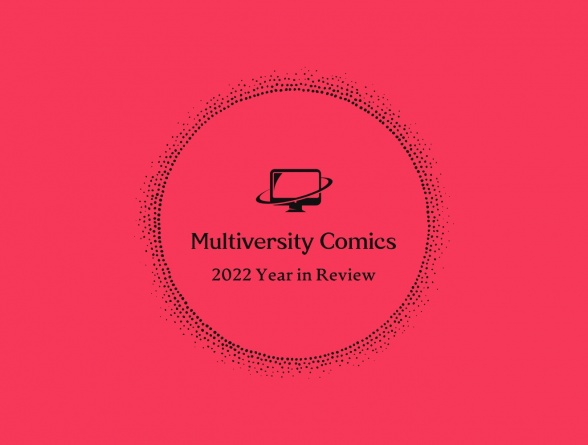
Welcome to the Multiversity Year in Review for 2022! We’ve got over 25 categories to get through, so make sure you’re checking out all of the articles by using our 2022 Year in Review tag.
In some circles, the distinction between comics and graphic novels is an important one, and possibly is even an indicator of the quality of the story. We know better! A graphic novel is simply a format. While a lot of comics are published in monthly floppy issues and eventually collected into paperback books, graphic novels are always intended to be books. It can be like the difference between a movie and a TV show; it’s partially a question of length, but the different format also has different storytelling concerns. 2022 was an exciting year for graphic novels, but there were eleven that were our absolute favorites

10. Bone Orchard Mythos: The Passageway
Part of the reason Jeff Lemire and Andrea Sorrentino’s “The Passageway” was one of my favorite OGNs of the year is because it’s an introduction to “The Bone Orchard Mythos” universe and the way it handles those introductory elements. It silently asks questions, not too many to overwhelm the narrative that spans just this book, but just enough that however “The Passageway” plays out, we will want more—in other words, a book that is paradoxically both satisfying and unsatisfying. And when I say “silently asks questions,” I mean the question isn’t in the speech balloons, but in the art itself. There are so many moments when John sees something and then reacts, and that’s all we need to know for this story, but the reaction also tells us “just you wait, there’s more to this…” and the book is confident enough in its storytelling to leave it at that.
I was also impressed by “The Passageway” because of its presentation. In case you don’t know, “The Bone Orchard Mythos” is a series that will span OGNs, short stories, one-shots, miniseries, maxiseries, and possibly other formats. The way “The Passageway” is constructed, it simply had to be an OGN. The opening pages of the book before the comic begins are a carefully constructed part of the experience. I can see why letterer Steve Wands is also the book’s designer, because it is an intrinsic part of the storytelling.
But it is Sorrentino’s work that gets me the most. He’s an artist that loves the power of panel composition and uses it to its full advantage. In the fourth panel of the comic, he is already telling readers John’s fate for those paying attention. And I feel like he’s well-matched with colorist Dave Stewart, who shares so many storytelling sensibilities. From the ground up, “The Orchard Mythos” feels like something designed as a playground for Sorrentino to stretch his talents in whatever way he sees fit, and it is such a joy to behold. But, y’know, a horrifying joy. – Mark Tweedale
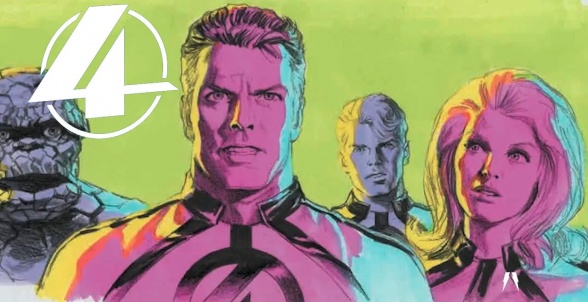
9. Fantastic Four: Full Circle
Here’s a book that was completely unexpected, and quite possibly, under read. A special event book written and drawn by Alex Ross, this Fantastic Four OGN may have missed your local comic shop simply because it wasn’t released through Marvel Comics, but rather Abrams ComicArts as a ‘Marvel Arts’ release. Meant as a tribute to Stan Lee and Jack Kirby, Ross revisits an existing Fantastic Four story from the 1960s and ties it into the characters’s grand histories and other storylines. Keeping the story distinctly in the 60s gives the book a beautiful and gee-whiz style that still manages to capture the love of these heroes and the depth of their legacy that should warm even the most cynical comic reader’s heart.
Ross’s script somehow keeps things groovy and soaring while allowing for some real weight, menace, terror, and most notably modern pacing to make this an incredibly strong effort. There are some truly horrifying moments that I, for one, never expected to see in a book like this, but Ross shows us just how dangerous and existentially terrifying the Neutral Zone and other cosmic elements of the Marvel Universe can be. It brings in the horrors of cosmic horror and superpowers that can be lacking from these high-flying types of sci-fi plots from years past. The book also manages to welcome in with open arms the Fantatic Four experts and the uninitiated, while referencing so much from their classic comics, it never leaves newcomers out in the cold. It pats old fans on the back and gently guides the hand of those new to the series without sluggishly pandering to either group.
Continued belowAnyone that knows Alex Ross’s name knows his incredible artwork. Having made his name with his work that is somehow both intrinsically comic book and pop art, while looking nearly photo-realistic, Ross is most known for his work on covers and the occasional full issue or OGN. This is the first time he has written and drawn a graphic novel. Through his writing and art he somehow manages to channel Lee and Kirby as if their ghosts were working through him, as well as bring this 60s storyline and somehow not only put it in the hands of today’s readers, but have them fully appreciate it without the needs to ask why it doesn’t look like a modern “Fantastic Four” book. The art is exquisite and so incredibly detailed it is a wonder that it didn’t take Ross even longer to complete it. At any moment there are a handful to 100s of characters and beings within a given page.
Assisting Ross with coloring duties is Josh Johnson who flawlessly blends in with Ross. Unless they decided to work separately when the book changes various palettes, which is does quite a few times, there is no telling where Ross and Johnson’s work ends or begins in that department. The work is a masterclass in this art style. It is nothing short of astonishing.
“Fantastic Four: Full Circle” is a truly joyous, terrifying, exciting, and gorgeous classic style comic book story that needs to be experienced and is, without a doubt, one of the best original graphic novels of the year. – Christopher Egan

8. Squire
I can’t remember now how Sara Alfageeh and Nadia Shammas’ “Squire” got on my radar, but I read the book as soon as it came out at the beginning of the year, so clearly I must’ve already been excited about it. And afterward, it was the OGN against which I measured all other OGNs for 2022, which is a big deal because we had some fantastic OGNs this year. There are many I haven’t read yet due to shipping issues or unavailability on digital platforms, yet this was the category I struggled with the most this year, trying to whittle my list down to only ten. Even still, “Squire” remained at the top.
I’ve already written about “Squire” for Best Breakthrough Artist and Best Lettering, so I’ll focus on story and character here. One of the key thematic elements of “Squire” is about how stories shape us, how we tell stories, and which stories we choose to let go of. This aspect is in play in almost every single scene, and continues to evolve right up to the final page. In big ways, it speaks about how stories can be used to shape a nation, about the face of war and of the enemy, but it’s also in the smaller ways this theme was explored—for me, the highlight was the relationship between Aiza and Husni. The two are practically friends immediately and with such ease, so it hurts later to discover that he believes the Empire’s narratives about the Ornu, especially since Aiza can’t tell him she’s Ornu. Later, when she saves him and in the process reveals her heritage, this act is dissected as some calculated move rather than a selfless act to save a friend.
There’s much more complexity to this plotline I’m omitting for brevity, but what it demonstrates so well is how any one of these infractions by Aiza’s friends aren’t borne out by maliciousness, but by the stories they’ve been told and how new information is always first placed in the framework of those stories. We see Aiza hurt again and again by these stories, and how they hold her down, and even when she rises up, how still they undermine everything she does. There is no version of success in this society that would ever let Aiza be truly happy. “Squire” is a story that’s critical of the stories we tell and why we tell them and what is worthy of being told. It’s why I enjoy it so much, and why I’m drawn back to rereading it. – Mark Tweedale

7. Clementine Book One
Continued belowFor award-winning cartoonist Tillie Walden, there are no boundaries. Sure, she could have remained content making autobiographical comics like “Spinning” that delighted audiences with its intimate and subdued portrayal of life as a young teenager, struggling with the traumas of adolescence. She could have stayed put in the indie arthouse bookshelves of your local comic book store with books like “I Love This Part” , a dream-pop ditty of a comic, describing the euphoric highs and incredible lows of first loves. Instead, in 2022 Walden teamed up with Image Comics giant Robert Kirkman and delivered a book that is the best of BOTH of those previous books, but set in the juggernaut IP universe that is “The Walking Dead.” It’s a swerve that most fans of Walden I would think found unexpected at the least, but in the end grateful for all the same.
Walden’s “Clementine” – a continuation of the story of a character introduced in a “Walking Dead” video game, no less – is a powerhouse of a book, a fantastic journey that enriches the world created by Kirkman (and artists Charlie Adlard and Tony Moore), while also allowing Walden to carve her own name into this universe. The book is clearly a survival horror zombie tale, as Clementine and an odd group of fellow teenage survivors struggle to create a livable community on top of a mountain, far away from the reaches of the zombie hordes, but also a surprisingly great YA coming of age tale about the tangled knots of young love. What makes “Clementine” sing, however, is Walden’s masterful orchestration of the two genres, the messy business of teens learning to love and become more adult is enhanced by the anxiety and paranoia inherent in the apocalypse they are struggling to survive. Walden’s art has never looked better, and watching this already very accomplished cartoonist stretch into the unfamiliar territory of body horror, gore, and violence is thrilling. Though sequels to “Clementine” were the plan from the start, this graphic novel reaches a compelling, tense, and satisfying conclusion that will have fans of both “The Walking Dead” and artist Tillie Walden breathing a small, content sigh of relief, and unmistakably wanting more. – Johnny Hall
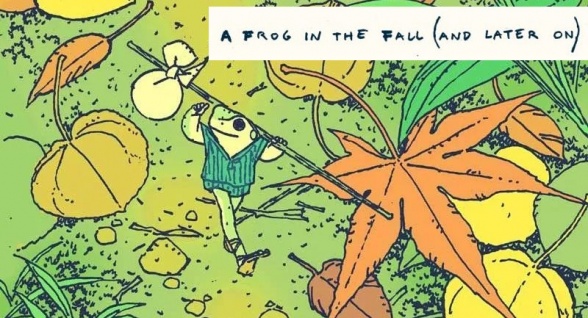
6. A Frog in the Fall
Linnea Sterte was an artist that I had on my radar for some time thanks to buzz from her previous book, “Stages of Rot.” So when the Kickstarter came around for her new, delightful book about an anthropomorphic froggy taking a trip downtown to discover himself, I didn’t hesitate to back the project.
I wasn’t prepared for how deeply this book would move me.
As soon as I sunk into “A Frog in the Fall,” I felt a sublime sense of calm. The book is immaculate. Even barely ten or so pages in, I was so moved by the rich atmosphere Sterte had established immediately. The format is horizontal, giving the book a fae-like, fable quality, that also gives the story a tonne of forward momentum. This is about our protagonist’s journey, literally through nature and through discovering his own sense of identity, and the layout drives this. The physical makeup of the book is absolutely incredible, too. The comic, presented in a gorgeous printed slipcase, is spineless, to ensure minimal gutter loss between pages and to immerse the reader as much as possible. It’s a fantastic, tactile reading experience.
Sterte’s mastery of detailing and negative space, visually and narratively, makes this book sing. We’re never inundated with worldbuilding, why tree spirits manifest as stylish human avatars or anything that might weigh the book down. Yet the little survival guides that the Frog and his toad companions discuss and work through give a very practical and engaging tone to the book. This goes for the art, too. Sterte provides rich backdrops as scene setters, from houses buried in lush vegetation and stone to stunning coastal panoramas. Yet most of this book is incredibly paired back. Often a whole page will depict only a single character or line of text, giving the reader a quiet moment to soak in the atmosphere of everything up to this point.
“Stages of Rot” may have put Sterte on the map, but for my money, “A Frog in the Fall” cements her as one of the most formidable and thoughtful cartoonists in recent years. – Rowan Grover
Continued below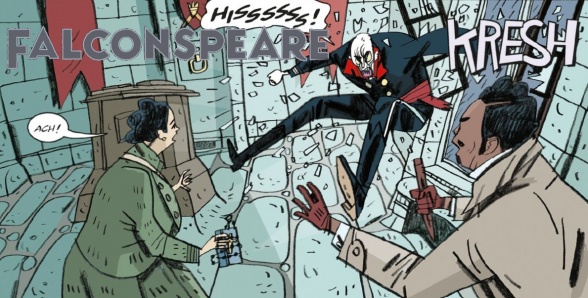
5. Falconspeare
One of the things that Mike Mignola does best is inspire his co-creators to take stories in directions that he, himself, wouldn’t necessarily write. Warwick Johnson-Cadwell, Mignola’s partner in the “Adventures of Professor J.T. Meinhardt and His Assistant Mr. Knox” series, has become the primary driver of these adventures and, while the Hammer horror influence hasn’t disappeared by a long shot, Johnson-Cadwell is very much telling the stories that he wants to tell with these characters.
Those stories are both of increasingly effective paranormal ‘hunters’ and also of a group of friends and confidants. That sounds a lot more soap opera-y than you’d expect a story about vampire hunters to be, but the melodrama and the vampire are often bed (or coffin, as it were) fellows, and Johnson-Cadwell isn’t exactly doing Victorian Melrose Place, either. But “Falconspeare,” the third of these collections, digs more into the interpersonal relationships between these characters than the monsters they to stop.
Johnson-Cadwell doesn’t allow this to eliminate some of the more humorous elements or the more gory, horror-focused ones. In fact, by ratcheting up the emotional stakes, both of those aspects appear more successful than in the past stories, because there is more oomph behind them. The friendship and tragedy of James Falconspeare becomes even more deeply felt because of the work that Johnson-Cadwell puts into the characters. In our review of the book, Mark Tweedale said that, on first reading, the beginning of the story felt a little slow, but what that means for the story is that we were given a rare opportunity to slow down and get to know these characters a little deeper. Knowing their motivations and relationships makes the end of the story, though inevitable, even more heartrending. – Brian Salvatore

4. The Night Eaters
Marjorie Liu is well recognized for her fantasy writing that it’s easy to forget that she started her writing career with horror and urban fantasy. This new graphic novel series, “The Night Eaters,” returns fully to her writing roots, inspired by the her experience and feelings of isolation during the first few years of COVID-19 pandemic. What came out of that loneliness was “The Night Eaters: She Eats the Night.” It’s a reflection of the immigrant experience and the realities of being a first generation Asian-American. It is also a lovely and charming look at the conflicts and tensions in a family that quite obviously love one another, mixed with supernatural horror Of the story her friend and usual comics co-creator Sana Takeda said in the afterword, “Marjorie shows me a wonderful world which I could never imagine.”
The first few pages are strangely charming and somehow endears the brusk and seemingly always irritable Ipo to us. Over the course of the book, we meet her both in 1950s China where she’s a movie stunt woman and in the present where she’s a chain smoking Chinese immigrant mother disappointed in her kids. She seems more concerned with her garden than her kids and their “Spam I Am” food stall. The supernatural horror aside, the core of this tale is the love, caring, and affection in the family and the way the secrets and mysteries they hide from each other – poorly – get in the way. It takes getting involved in the haunting across the street to bring them together and, through that painful experience, to open up to each other.
Sana Takeda’s art merges so well with the script that the whole book feels seamless. Takeda has such a command of setting and expression that you can’t help but be drawn into the magic of this tale. We never fully learn what Ipo, her husband, or her kids really are. We don’t know what the person across the street summoned either, other than it didn’t belong here in the form it was in. – Greg Lincoln

3. Reckless: The Ghost in You
“The Ghost in You” is a different sort of “Reckless” book, different perspective, different genre, but the same central concepts. It’s a book about LA, its history, and the vintage media threaded into that unique time and place. The story, which follows Anna’s first solo case investigating the haunted mansion of an LA Scream Queen, has this knack for exploring benign sadness. There’s heavy moments here, but it’s the divergences into each characters personal outlook that are truly poignant. This book gets to be a bit more of a family drama too, which is a change of pace after Ethan’s usually stoicism.
Continued belowProbably the closest prior work to this from Brubaker and Phillips is “The Fade Out,” which used its vintage influences to paint a similar kind of Hollywood character drama, but where that planted itself firmly within the celebrities and studios, “The Ghost in You” takes a retrospective approach. It’s a different kind of ghost story, a classic set up set in an era that’s passed the story by, a reinterpretation of the symbolic movie theater Anna and Ethan have shared through the series. Lorna Valentine is a great new character too, and helps tie together the generational story of Lamore Mansion.
Ultimately, these books succeed on a collaborative team with great instincts and intuitive story structure, we get a mystery that moves quickly, another exceptional scumbag villain, and like all good stories, a wedding to end with that’s just about the most beautiful part. With the A-side/B-side set-up for “The Ghost in You” and “Follow Me Down” we’re presented with two stories made even stronger and more poignant because of their proximity. It’s the sort of set-up you can only do when you have confidence in a series, and after a great opening trilogy, it feels like that confidence is here in “The Ghost in You.” I can’t wait to see where that confidence takes Anna and Ethan next. – James Dowling

2. Ducks
There is a beautiful, quiet moment in “Ducks” by cartoonist Kate Beaton where amidst a frigid, below zero night on the oil sands of Alberta, Canada where young “Katie” works, often holed up in the tool crib, handing out and cleaning tools for her almost exclusively male co-workers, as she steps outside and happens to look up. What she sees is the aurora borealis, the beautiful Northern Lights, lovingly recreated by Beaton in a double page splash, combining the beauty of the natural wonder and the harsh, decidedly un-beautiful area of the worker camp that surrounds her. In this 400-plus page graphic novel covering two years of Kate’s life as the employee of various oil companies, we see an altogether different side of the beloved cartoonist. The story is so many things – first and foremost a powerful treatise on the exploitation of people, land, and resources as Katie’s simple journey westward to make big cash and pay off student loans becomes a deeper understanding of how companies abuse people, not just the workers they employ but the people of the lands they infiltrate – most notably here the First Nations tribes who are poisoned by the toxic chemicals pumped into the soil by the oil extraction process. It’s also an inside look at the complicated world of these oil sands worker camps, rife with sexual violence, daily harassment, rampant drug use, and untold numbers of mental illnesses that develop due to the volatile environs and the harsh isolation from family and home (most of the workers come from all over Canada – all over the world, in fact – and are far from their homeland). It’s also a bitingly funny blue-collar workplace comedy, Beaton understanding the need to tell a complete picture and sharing moments of silly, mundane workplace interactions and of true friendships she made within the confines of the camp. Finally, though by no means least important, this is the bold, honest confessional of a woman who has lived through these camps and suffered its indignities, coming out the other side and wanting to share her experience. “Ducks” triumphs because of the well-roundedness of Beaton’s storytelling, which never feels rushed, taking time to set up her journey westward, making sure we spend time with these men and women itinerant workers, to understand the brutality and carelessness that surrounds them – hell, employs them. As she enters the labor force within the camp, the incidents first seem awkward and uncomfortable, from stares that last too long, to full on neck craning. However, the banality of this pervasive sexual violence is only a precursor to the rot at the core, as Beaton “learns to live with” the looks for the sake of the money, she accepts, and experiences, more and more of the harassment – looks have turned to full on intimidation, and worse. When Katie’s sister Becky and her friend come out to the oil sands to join her and work, Katie feels like she has cursed the two, along with herself. The titular ducks, in fact, describe an incident in which ducks, normally driven off the oil sands by technological means, stopped on a pond in the sands and were quickly killed by the toxicity, a brilliant and heartbreaking metaphor for the entire enterprise.
Continued below“Ducks: Two Years on the Oil Sands” is a book you will want to sit with after reading, sit with and really ruminate. The issues of environmentalism, capitalism, sexual politics, the rights of First Nation Peoples, and toxic masculinity intersect pervasively in the small insular worlds of these worker camps where for every sexual predator there is another person just trying to provide for their family, a family that is likely thousands of miles away. It is a complicated microcosm with an extremely volatile ecosystem, driven by the greed and carelessness of the corporations that run them. This delicate microcosm could have easily tipped out of balance in the hands of a lesser creator, but in Beaton’s skillful hands, hands that have worked these very sands, the balance stays in place and while her experience may not be universal, it absolutely rings truthful. For those of us who have followed Beaton since her “Hark! A Vagrant” webcomic days, a comic she started during her time in the sands, in fact, it has been a great delight seeing her rise to fame, but more importantly being able to experience her growth as an artist. In a fantastic scene towards the end of the novel an older coworker notices Katie’s got something in her “scribbler.” After Katie explains her comics as something she makes “in my free time – it’s something I get to have for me,” the co-worker says in perfectly polite Canadian fashion “Hmm. I’ll have to watch where you end up with these characters.” With “Ducks,” the beautiful work of art that we here at Multiversity found one of our very favorites of 2022, we see the Northern Lights against the harsh oil sands of Alberta, Canada. A work of tremendous depth and grace against the cold backdrop of exploitation. – Johnny Hall
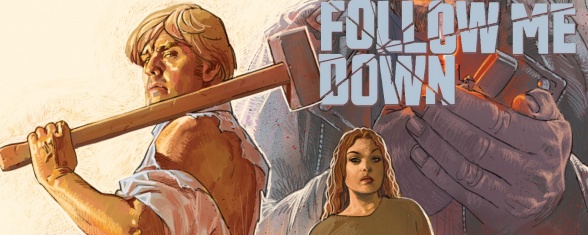
1. Reckless: Follow Me Down
Ed Brubaker and Sean Phillips had three of the top 10 original graphic novels last year. I think it’s safe to say these two are on a roll with their “Reckless” series. They released two great graphic novels this year each better than the last.
“Reckless” continues to defy expectations with every new installment and “Follow Me Down” is no exception. This story pairs with “The Ghost In You” showcasing what happened in Ethan’s life concurrent with Anna’s from the previous book.
“Follow Me Down” contains everything we’ve come to expect from “Reckless”. A deep mystery, gratuitous violence, love disguised as sex and sex disguised as love. But most of all it features a truly tragic story that leads a woman to seek revenge. Ethan gets mixed up in her revenge plot and Brubaker uses it to show us their characters and motivations. The book picks up the story in multiple time periods and gives us the most complete look at this world yet. Brubaker makes every moment feel authentic and real to these characters. We are left with an even deeper understanding of Ethan than we’ve had across the whole series.
I love that a book so firmly rooted in the pulp fiction stories of the past gets printed in beautiful hardcover with some of the best art in comics today. Phillips is firing on all cylinders throughout. It elevates the art form of the pulp novel to what its proponents always knew it deserved. If you’ve been following Ethan Reckless’ journey so far, his latest case won’t let you down. – Matthew Vincenty






